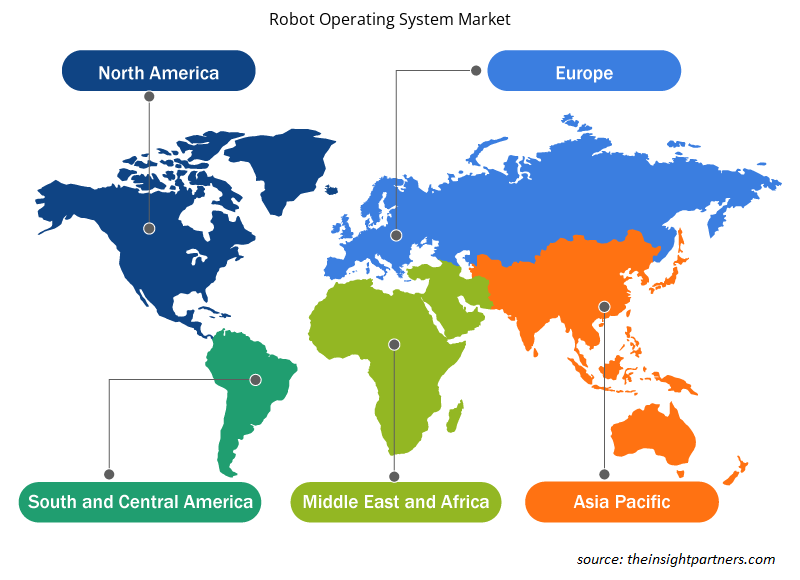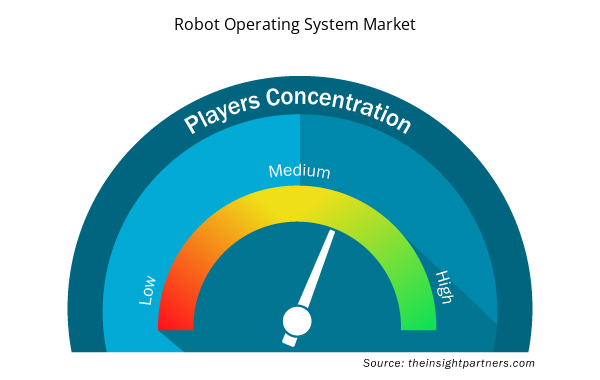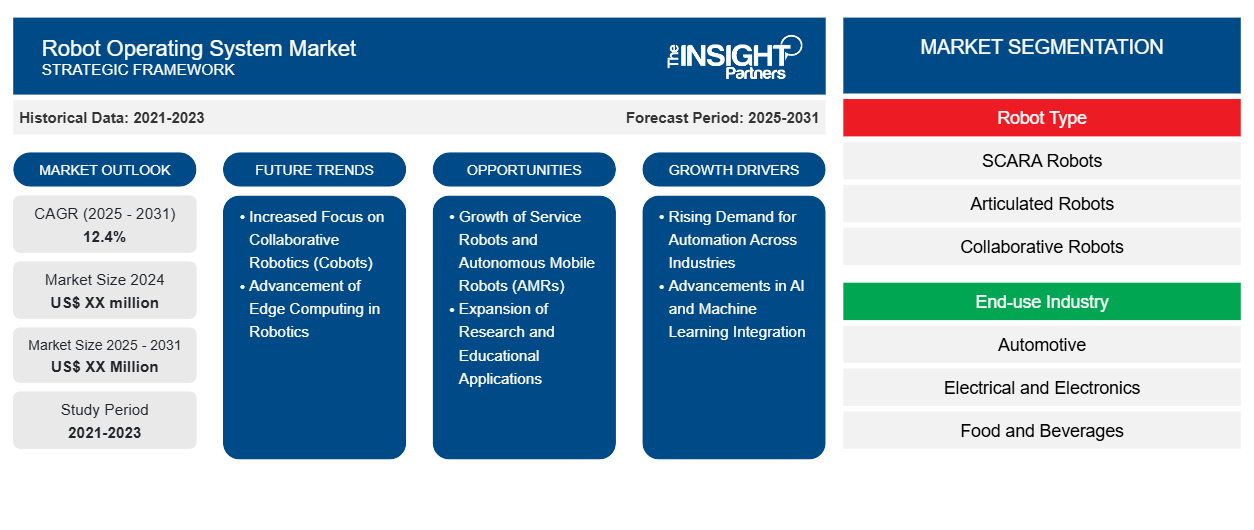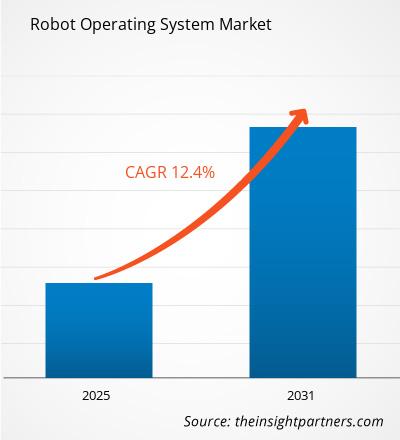ロボットオペレーティングシステム市場は、2023年から2031年にかけて12.4%のCAGRで成長し、市場規模は2023年のXX百万米ドルから2031年にはXX百万米ドルに拡大すると予想されています。
レポートは、ロボットの種類(スカラロボット、多関節ロボット、協働ロボット、直交ロボット、パラレルロボット、その他)、最終用途産業(自動車、電気・電子、食品・飲料、ヘルスケア、金属・機械、その他)別にセグメント化されています。グローバル分析は、地域レベルと主要国でさらに細分化されています。レポートは、上記の分析とセグメントに対して米ドルでの価値を提供します。
報告書の目的
The Insight Partners のレポート「ロボット オペレーティング システム市場」は、現在の状況と将来の成長、主な推進要因、課題、機会を説明することを目的としています。これにより、次のようなさまざまなビジネス関係者に洞察が提供されます。
- テクノロジープロバイダー/メーカー: 進化する市場の動向を理解し、潜在的な成長機会を把握することで、情報に基づいた戦略的意思決定が可能になります。
- 投資家: 市場の成長率、市場の財務予測、バリュー チェーン全体に存在する機会に関する包括的な傾向分析を実施します。
- 規制機関: 市場の濫用を最小限に抑え、投資家の信用と信頼を維持し、市場の完全性と安定性を維持することを目的として、市場における政策と警察活動を規制します。
ロボットオペレーティングシステム市場のセグメンテーション
ロボットタイプ
- スカラロボット
- 多関節ロボット
- 協働ロボット
- 直交ロボット
- パラレルロボット
- その他
最終用途産業
- 自動車
- 電気・電子
- 食品・飲料
- 健康管理
- 金属および機械
- その他
要件に合わせてレポートをカスタマイズする
このレポートの一部、国レベルの分析、Excelデータパックなど、あらゆるレポートを無料でカスタマイズできます。また、スタートアップや大学向けのお得なオファーや割引もご利用いただけます。
- このレポートの主要な市場動向を入手してください。この無料サンプルには、市場動向から見積もりや予測に至るまでのデータ分析が含まれます。
ロボットオペレーティングシステム市場の成長要因
- 業界全体で高まる自動化の需要: 製造、物流、医療、農業など、さまざまな業界で自動化の導入が進んでいることが、ロボット オペレーティング システム (ROS) 市場の大きな推進力となっています。ROS は、開発者がロボット システムを効率的に構築および制御できるようにする柔軟なモジュール フレームワークを提供するため、産業用ロボット、自律走行車、サービス ロボットに最適です。業界が自動化を通じて生産性を高め、コストを削減し、精度を向上させる方法を模索する中、これらのロボット システムをサポートする ROS プラットフォームの需要が急速に高まっています。
- AI と機械学習の統合の進歩: 人工知能 (AI) と機械学習 (ML) のテクノロジーとロボット工学の統合は、ROS 市場のもう一つの重要な推進力です。ROS は AI および ML アルゴリズムと高い互換性があり、ロボットが複雑なタスクを実行し、変化する環境に適応し、リアルタイムで意思決定を行うことを可能にします。ROS を通じて高度な認識、ナビゲーション、意思決定機能を統合する能力は、特に自律走行車、ドローン、インテリジェント製造システムなどの分野でその採用を加速させています。
ロボットオペレーティングシステム市場の将来動向
- 協働ロボット (コボット) への注目度の高まり: ROS 市場の顕著なトレンドは、共有ワークスペースで人間のオペレーターと一緒に作業するように設計された協働ロボット (コボット) の増加です。これらのロボットは、調整、リアルタイムの意思決定、および安全性の監視に ROS に大きく依存しています。製造、物流、医療などの業界が生産性と安全性の向上のためにコボットを採用するにつれて、複雑な人間とロボットの相互作用を処理できる ROS 駆動型プラットフォームの需要が高まっています。ROS のモジュール式アーキテクチャは、コボット アプリケーションに必要な適応性と柔軟性を備えたシステムの開発に最適です。
- ロボティクスにおけるエッジ コンピューティングの進歩: エッジ コンピューティングとロボティクスの統合は、ROS 市場の新たなトレンドの 1 つです。エッジ コンピューティングにより、ロボットはデータを中央サーバーに送信するのではなく、デバイス上でローカルに処理できるため、レイテンシが短縮され、リアルタイムの意思決定機能が向上します。ROS がエッジ コンピューティング フレームワークをサポートしているため、ロボットはクラウド インフラストラクチャに大きく依存することなく、リアルタイム ナビゲーションや自律的な意思決定などのより複雑なタスクを処理できます。このトレンドは、自律走行車、ドローン、産業用ロボットなど、低レイテンシとリアルタイムの応答が重要なアプリケーションで特に重要です。
ロボットオペレーティングシステムの市場機会
- サービス ロボットと自律移動ロボット (AMR) の成長: 医療、接客業、小売業などの分野でサービス ロボットの使用が増えていることは、ROS 市場にとって大きなチャンスです。配達ロボット、清掃ロボット、医療アシスタントなどのサービス ロボットは、ナビゲーション、物体認識、タスク管理に ROS を大いに活用しています。倉庫、配送センター、ラスト マイル配送サービスにおける自律移動ロボット (AMR) の需要増加も、大きな成長機会を生み出しています。ROS は、これらのロボットのシームレスな統合とパフォーマンス強化に必要なツールを提供できるため、サービス ロボットと物流自動化に大きな市場の可能性が生まれます。
- 研究および教育アプリケーションの拡大: ROS 市場のもう 1 つのチャンスは、学術機関や研究機関における ROS の使用拡大にあります。ROS はオープンソースで高度にカスタマイズ可能なため、ロボット工学、AI、自動化を教える教育現場でますます使用されています。多くの大学や研究室では、ROS を使用して実験用ロボット システムを開発し、ロボット工学、AI、IoT などのさまざまな領域で実験を行っています。ロボット工学と STEM (科学、技術、工学、数学) 教育に重点を置いた教育プログラムの増加により、ROS プラットフォームの採用が促進され、ROS 上に構築された教育ツールやリソースの新しい市場が生まれています。
ロボットオペレーティングシステム市場の地域別分析
予測期間を通じてロボット オペレーティング システム市場に影響を与える地域的な傾向と要因は、Insight Partners のアナリストによって徹底的に説明されています。このセクションでは、北米、ヨーロッパ、アジア太平洋、中東、アフリカ、南米、中米にわたるロボット オペレーティング システム市場のセグメントと地域についても説明します。

- ロボットオペレーティングシステム市場の地域別データを入手
ロボットオペレーティングシステム市場レポートの範囲
| レポート属性 | 詳細 |
|---|---|
| 2023年の市場規模 | XX百万米ドル |
| 2031年までの市場規模 | XX百万米ドル |
| 世界のCAGR(2023年~2031年) | 12.4% |
| 履歴データ | 2021-2022 |
| 予測期間 | 2024-2031 |
| 対象セグメント | ロボットの種類別
|
| 対象地域と国 | 北米
|
| 市場リーダーと主要企業プロフィール |
|
ロボットオペレーティングシステム市場のプレーヤー密度:ビジネスダイナミクスへの影響を理解する
ロボット オペレーティング システム市場は、消費者の嗜好の変化、技術の進歩、製品の利点に対する認識の高まりなどの要因により、エンド ユーザーの需要が高まり、急速に成長しています。需要が高まるにつれて、企業は提供内容を拡大し、消費者のニーズを満たすために革新し、新たなトレンドを活用し、市場の成長をさらに促進しています。
市場プレーヤー密度とは、特定の市場または業界内で活動している企業または会社の分布を指します。これは、特定の市場スペースに、その市場規模または総市場価値に対してどれだけの競合相手 (市場プレーヤー) が存在するかを示します。
ロボットオペレーティングシステム市場で事業を展開している主要企業は次のとおりです。
- ABB株式会社
- クリアパスロボティクス
- 株式会社デンソー
- ファナック株式会社
- クーカAG
免責事項:上記の企業は、特定の順序でランク付けされていません。

- ロボットオペレーティングシステム市場のトップキープレーヤーの概要を入手
主なセールスポイント
- 包括的なカバレッジ: レポートでは、ロボット オペレーティング システム市場の製品、サービス、タイプ、エンド ユーザーの分析を包括的にカバーし、全体的な展望を提供します。
- 専門家による分析: レポートは、業界の専門家とアナリストの深い理解に基づいてまとめられています。
- 最新情報: このレポートは、最新の情報とデータの傾向を網羅しているため、ビジネスの関連性を保証します。
- カスタマイズ オプション: このレポートは、特定のクライアント要件に対応し、ビジネス戦略に適切に適合するようにカスタマイズできます。
したがって、ロボット オペレーティング システム市場に関する調査レポートは、業界のシナリオと成長の見通しを解読して理解する道の先導役となる可能性があります。正当な懸念事項がいくつかあるかもしれませんが、このレポートの全体的な利点は欠点を上回る傾向があります。
- 過去2年間の分析、基準年、CAGRによる予測(7年間)
- PEST分析とSWOT分析
- 市場規模価値/数量 - 世界、地域、国
- 業界と競争環境
- Excel データセット


- Grant Management Software Market
- Biopharmaceutical Tubing Market
- High Speed Cable Market
- Airport Runway FOD Detection Systems Market
- Industrial Valves Market
- Portable Power Station Market
- Health Economics and Outcome Research (HEOR) Services Market
- Cell Line Development Market
- Educational Furniture Market
- Mesotherapy Market

Report Coverage
Revenue forecast, Company Analysis, Industry landscape, Growth factors, and Trends

Segment Covered
This text is related
to segments covered.

Regional Scope
North America, Europe, Asia Pacific, Middle East & Africa, South & Central America

Country Scope
This text is related
to country scope.
よくある質問
Some of the customization options available based on the request are an additional 3-5 company profiles and country-specific analysis of 3-5 countries of your choice. Customizations are to be requested/discussed before making final order confirmation# as our team would review the same and check the feasibility
The report can be delivered in PDF/PPT format; we can also share excel dataset based on the request
The integration of artificial intelligence (AI) and machine learning (ML) with ROS is anticipated to play a significant role in the global Robot Operating System market in the coming years
The major factors driving the Robot Operating System market are Increased Adoption in Industries and Expansion of E-commerce.
The Robot Operating System Market is estimated to witness a CAGR of 12.4% from 2023 to 2031
-
Trends and growth analysis reports related to Electronics and Semiconductor : READ MORE..
1. ABB Ltd.2. Clearpath Robotics3. DENSO Corporation4. FANUC Corporation5. KUKA AG6. Microsoft Corporation7. Omron Corporation8. Rethink Robotics GmbH9. Universal Robots10. Yaskawa Electric Corporation
The Insight Partners performs research in 4 major stages: Data Collection & Secondary Research, Primary Research, Data Analysis and Data Triangulation & Final Review.
- Data Collection and Secondary Research:
As a market research and consulting firm operating from a decade, we have published and advised several client across the globe. First step for any study will start with an assessment of currently available data and insights from existing reports. Further, historical and current market information is collected from Investor Presentations, Annual Reports, SEC Filings, etc., and other information related to company’s performance and market positioning are gathered from Paid Databases (Factiva, Hoovers, and Reuters) and various other publications available in public domain.
Several associations trade associates, technical forums, institutes, societies and organization are accessed to gain technical as well as market related insights through their publications such as research papers, blogs and press releases related to the studies are referred to get cues about the market. Further, white papers, journals, magazines, and other news articles published in last 3 years are scrutinized and analyzed to understand the current market trends.
- Primary Research:
The primarily interview analysis comprise of data obtained from industry participants interview and answers to survey questions gathered by in-house primary team.
For primary research, interviews are conducted with industry experts/CEOs/Marketing Managers/VPs/Subject Matter Experts from both demand and supply side to get a 360-degree view of the market. The primary team conducts several interviews based on the complexity of the markets to understand the various market trends and dynamics which makes research more credible and precise.
A typical research interview fulfils the following functions:
- Provides first-hand information on the market size, market trends, growth trends, competitive landscape, and outlook
- Validates and strengthens in-house secondary research findings
- Develops the analysis team’s expertise and market understanding
Primary research involves email interactions and telephone interviews for each market, category, segment, and sub-segment across geographies. The participants who typically take part in such a process include, but are not limited to:
- Industry participants: VPs, business development managers, market intelligence managers and national sales managers
- Outside experts: Valuation experts, research analysts and key opinion leaders specializing in the electronics and semiconductor industry.
Below is the breakup of our primary respondents by company, designation, and region:

Once we receive the confirmation from primary research sources or primary respondents, we finalize the base year market estimation and forecast the data as per the macroeconomic and microeconomic factors assessed during data collection.
- Data Analysis:
Once data is validated through both secondary as well as primary respondents, we finalize the market estimations by hypothesis formulation and factor analysis at regional and country level.
- Macro-Economic Factor Analysis:
We analyse macroeconomic indicators such the gross domestic product (GDP), increase in the demand for goods and services across industries, technological advancement, regional economic growth, governmental policies, the influence of COVID-19, PEST analysis, and other aspects. This analysis aids in setting benchmarks for various nations/regions and approximating market splits. Additionally, the general trend of the aforementioned components aid in determining the market's development possibilities.
- Country Level Data:
Various factors that are especially aligned to the country are taken into account to determine the market size for a certain area and country, including the presence of vendors, such as headquarters and offices, the country's GDP, demand patterns, and industry growth. To comprehend the market dynamics for the nation, a number of growth variables, inhibitors, application areas, and current market trends are researched. The aforementioned elements aid in determining the country's overall market's growth potential.
- Company Profile:
The “Table of Contents” is formulated by listing and analyzing more than 25 - 30 companies operating in the market ecosystem across geographies. However, we profile only 10 companies as a standard practice in our syndicate reports. These 10 companies comprise leading, emerging, and regional players. Nonetheless, our analysis is not restricted to the 10 listed companies, we also analyze other companies present in the market to develop a holistic view and understand the prevailing trends. The “Company Profiles” section in the report covers key facts, business description, products & services, financial information, SWOT analysis, and key developments. The financial information presented is extracted from the annual reports and official documents of the publicly listed companies. Upon collecting the information for the sections of respective companies, we verify them via various primary sources and then compile the data in respective company profiles. The company level information helps us in deriving the base number as well as in forecasting the market size.
- Developing Base Number:
Aggregation of sales statistics (2020-2022) and macro-economic factor, and other secondary and primary research insights are utilized to arrive at base number and related market shares for 2022. The data gaps are identified in this step and relevant market data is analyzed, collected from paid primary interviews or databases. On finalizing the base year market size, forecasts are developed on the basis of macro-economic, industry and market growth factors and company level analysis.
- Data Triangulation and Final Review:
The market findings and base year market size calculations are validated from supply as well as demand side. Demand side validations are based on macro-economic factor analysis and benchmarks for respective regions and countries. In case of supply side validations, revenues of major companies are estimated (in case not available) based on industry benchmark, approximate number of employees, product portfolio, and primary interviews revenues are gathered. Further revenue from target product/service segment is assessed to avoid overshooting of market statistics. In case of heavy deviations between supply and demand side values, all thes steps are repeated to achieve synchronization.
We follow an iterative model, wherein we share our research findings with Subject Matter Experts (SME’s) and Key Opinion Leaders (KOLs) until consensus view of the market is not formulated – this model negates any drastic deviation in the opinions of experts. Only validated and universally acceptable research findings are quoted in our reports.
We have important check points that we use to validate our research findings – which we call – data triangulation, where we validate the information, we generate from secondary sources with primary interviews and then we re-validate with our internal data bases and Subject matter experts. This comprehensive model enables us to deliver high quality, reliable data in shortest possible time.


 このレポートの無料サンプルを入手する
このレポートの無料サンプルを入手する